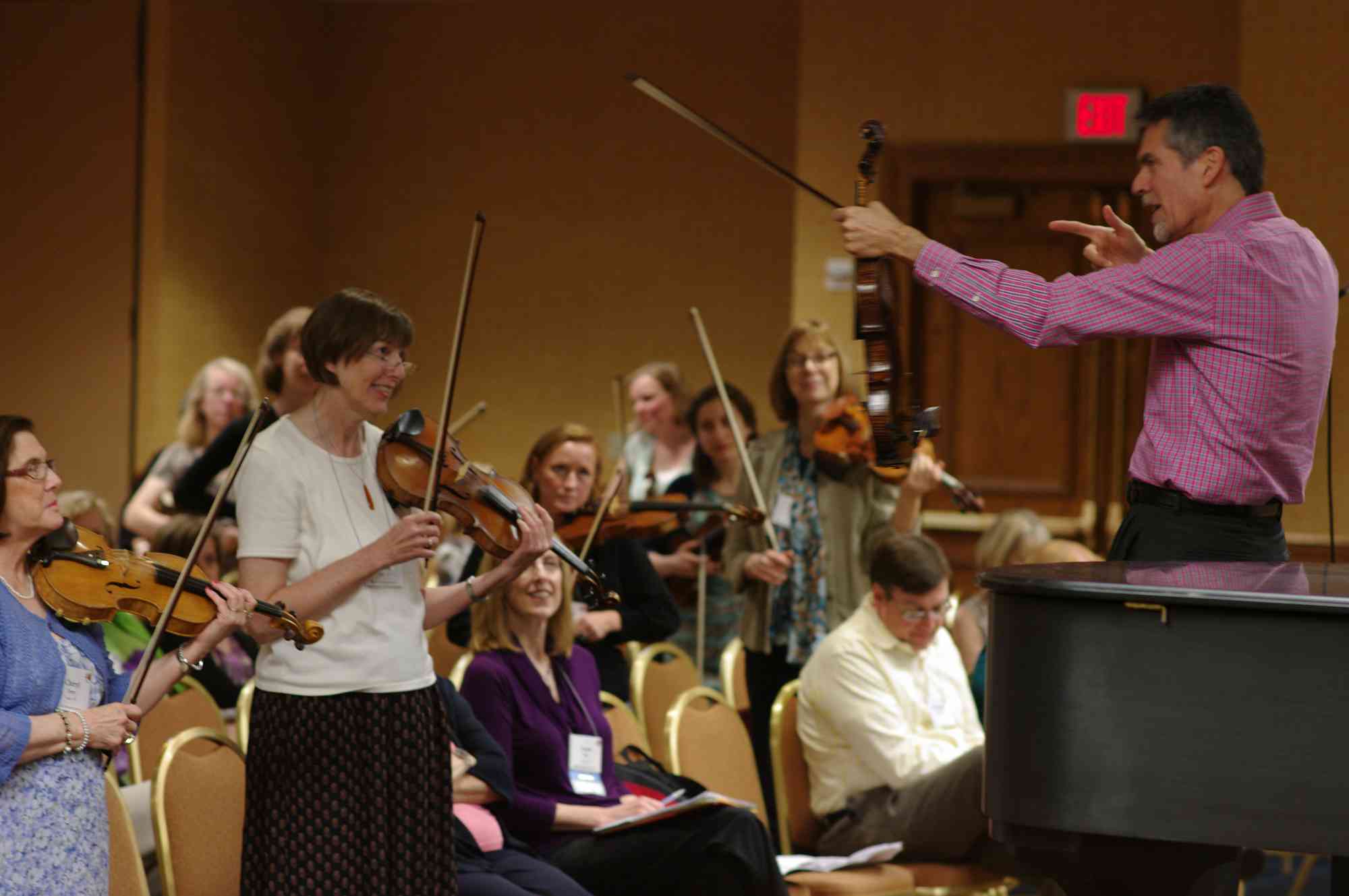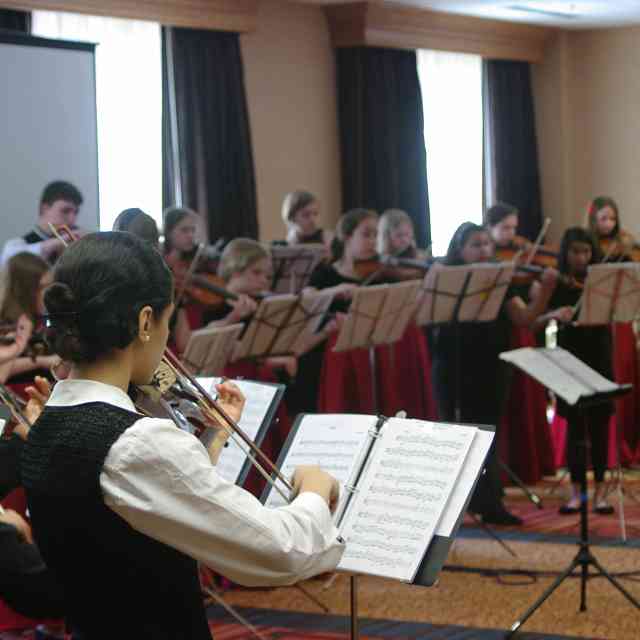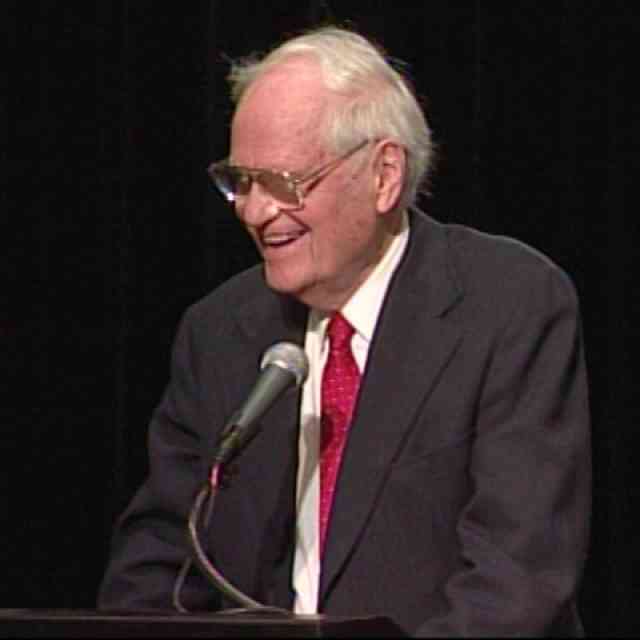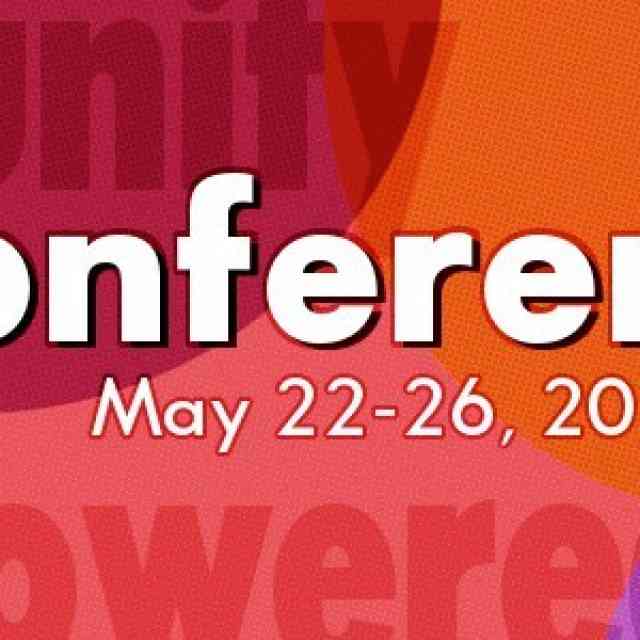The conference sessions for violinists provided a menu of irresistible treats. There were so many intriguing titles that it was impossible to see everything on my list of top picks. On the flip side, no one complained of opting to go shopping due to a lack of interesting possibilities! A huge ovation goes to the cast of more than seventy-five presenters and volunteers who collaborated to make everything run smoothly and efficiently—a tribute to all of the beautiful hearts within our Suzuki community!
A Celebration of Bach
One of the themes of the 2012 conference was the music of Bach, a staple of the violin repertoire. Four sessions focused on Bach’s contributions, both within the Suzuki literature and beyond. Teri Einfeldt and Michael McLean started us off with a session titled “Bach in the Books for Violinists.” First, Ms. Einfeldt identified the progression of skills that are developed through the Bach pieces in the Suzuki violin books that lead to successful navigation of the Unaccompanied Sonatas and Partitas. For the left hand, she gave detailed examples of when to leave fingers down and when to pick them up, when to expand and contract the hand, and how to prepare double stops. To prepare the bow, she discussed string crossings, comfort at the frog, chords and double stops, bow speed, articulation and rhythmic subdivisions. Mastering these skills at every level is necessary to enable students to successfully study the unaccompanied gems of Bach. Michael McLean followed by stressing the importance of having a structural understanding of Bach’s works. He pointed out opportunities in the repertoire for recognizing rhythmic and melodic counterpoint between the bass line and the melody, sequences, tonal centers, cadences, and compound melodic and rhythmic structures. Michael beautifully arranged the opening of the first movement of the Bach Double, allowing the audience to experience the different voices (s, a, t, b) as four distinct lines. Those in attendance left with a renewed respect for the powerful teaching possibilities inherent in the Bach repertoire of Dr. Suzuki’s violin books.
Our special guest artist and clinician, Katie Lansdale, expanded our understanding of Bach by presenting a keynote address titled “Advanced Students’ Explorations of Interpreting Bach,” as well as performing several movements of the Sonatas and Partitas for Solo Violin and working with students on the same literature in a master class. In her keynote, Katie was able to share a perspective derived from her intimate and extensive experience with the unaccompanied works. She commented on how brilliant it was for Dr. Suzuki to thread Bach’s music throughout the books, because the presence of these pieces strongly influences not only a child’s musical development, but the development of character as well. She suggested that once a child is prepared to delve into the unaccompanied literature, the music should not be introduced as daunting or intimidating, but rather offered as a gift for students to explore and discover its secrets. On a more technical level, Ms. Lansdale talked about the importance of finger flexibility in passages or movements with steady sixteenth notes, the execution of double-stops and chords, understanding and expressing the hierarchy of complex rhythms, voicing, and recognizing underlying harmonic progressions. She also offered several suggestions for memorizing Bach such as making a roadmap by labeling forks in the road, imagining a story about the journey through the piece, color-coding or assigning characters to the voices in a fugue, studying the music without the instrument, and practicing starting from the end of the piece. Following the lecture, Ms. Lansdale demonstrated the eloquent results of these carefully considered concepts by performing several movements from Bach’s unaccompanied literature and closing with her gift of the beautiful Chaconne.
The ensuing master class gave us the opportunity to appreciate Bach from the perspective of revealing the mysteries of his music to students. Each student performed a movement from the E major Partita, Maryanne Kirsh choosing the Loure and Sofya Norman, the Gavotte en Rondeau. Ms. Lansdale was quick to commend them for their excellent preparation, and also for their eager and intelligent responses to the suggestions given within this teaching/learning environment. Teaching points included the importance of posture as it relates to ease of playing and tone production, emphasizing the imitative or duet nature of certain passages, using creative bowings in order to better express the lines, exploring bow strokes that evoke a dance character, and selecting a tempo based on previously learned similar dances, i.e., all gavottes are approximately the same tempo. This master class was very informative, yielding beautiful results. Ms. Lansdale demonstrated the power of teaching from a platform of knowledge and passion for her subject matter while showing respect for the students and their work.
Tone
No SAA conference would be complete without a session or two devoted to the consideration of tone, a subject which is central to Suzuki education. Considering its importance to violin playing, the topic was broached in several sessions, but two presentations were devoted purely to tone. Appropriately, these sessions opened and closed the conference line-up.
Cathy Lee attuned our senses to the quality of fine tone by starting us off with a participatory session, “Your Best Other Bow Hold Part II: Exploring Right Hand Technique.” This was the sequel to a similar session that Ms. Lee offered at the 2010 conference. The exercises presented were learned from Dr. Suzuki when Ms. Lee studied in Japan. They provide an efficient and creative way to train the muscle skills and physical coordination needed for a beautiful sounding legato, detache, staccato, spiccato, etc. Organized in true Suzuki fashion, Ms. Lee asked us to first perform each bow exercise without the violin, then experience it on a familiar piece, and finally apply it to more advanced literature. We came away with many fun and effective tools for exploring tone and bow technique.
Sandy Reuning brought our attention back to tone on the last day of the conference with his session, titled “Give My Regards to Kreisler: Shinichi Suzuki’s Thirty Years of Zen Meditation on Tone.” Mr. Reuning pointed out that Dr. Suzuki has written two books on the subject of tone. The first is Tonalization (1955), which has been available for many years. The second is Philosophy of Tone Production (1960), which has only recently been translated to English and is soon to be published. Mr. Reuning explained that Suzuki’s fascination with tone began with a model that he recognized in the artists Fritz Kreisler and Pablo Casals. Once he identified these artists as producing his ideal for tone, he spent years figuring out how to replicate it and incorporate it in his own playing. If we approach tone in this manner, our listening skills can be keenly refined. Mr. Reuning left us with three admonitions from Suzuki: Play with Kreisler’s beautiful tone, learn correct technique, and play from your heart.
Violin Literature
Allen Lieb, Chair of the SAA Violin Committee, led us on an exploration of the new written and corollary technical materials presented in Suzuki Books 1–5 and the opportunities they offer for enriched student and parent education. Through continued research and experimentation, Dr. Suzuki supplemented his repertoire with numerous exercises and ideas designed to guide the layering of acquired skills. When updating the Suzuki violin books, the International Suzuki Association Violin Committee has had two main goals:
-
To examine the original sources for greater accuracy.
-
To restore the materials Dr. Suzuki originally intended to be included in students’ training.
Some of this seemingly “new” material was never published outside of Japan, and some was presented by Dr. Suzuki at conferences and included in study guides which are not widely available to today’s teachers. In addition, there are wonderful resources in the revised books that teachers have previously had to provide separately to students and parents. Among the materials included in the new volumes are: Dr. Suzuki’s message to parents about ability development and study points, instrument tuning and maintenance information, labeled diagrams of the violin and bow parts, illustrations of proper playing posture, additional bow, rhythm, and tone exercises, previews to upcoming pieces, glossaries of musical terms, notation guides, composer biographical information, sources for listening, and fingering charts. The session concluded with an opportunity for teachers to play a number of the revised pieces and exercises while Mr. Lieb shared the ways he incorporates them into his teaching.
With her usual wit and repartee, Carol Dallinger began her presentation, “The Forgotten Suzuki Materials for Violin,” by suggesting an alternate title, “Stuff from the Old Days.” The material to which she referred included some published resources as well as some unpublished pedagogical information possessed by teachers who had the privilege of studying with Dr. Suzuki. Among the published materials written by Suzuki are the “Position Etudes,” “Quint Etudes,” “Tonalization,” and “Notereading.” Ms. Dallinger also recommended the book Shinichi Suzuki: The Man and His Philosophy by Evelyn Hermann, because it includes some of Dr. Suzuki’s speeches and excerpts from his “Vital Points” materials distributed to teachers each year. Ms. Dallinger encouraged us to take advantage of the audio-video recordings of Suzuki which were made at the American Suzuki Institute in 1976. Additionally, Ms. Dallinger shared some unpublished resources and participants enjoyed trying out several of Dr. Suzuki’s “new ideas” using pencils and rubber bands.
Barbara Barber’s session, “The Road to Mozart: Getting Ready for the Concertos,” was full of useful ideas and information about preparing students to play the Mozart Concertos in Books Nine and Ten. Ms. Barber provided a list of skills and concepts that must be mastered in preparation for these concertos which includes specific right- and left-hand techniques, ornamentation, phrasing, contrasting characters, forms, and cadenzas. Opportunities to learn these skills in the Suzuki repertoire as well as supplemental repertoire were pointed out, demonstrated and discussed. Since there are few student-level concertos from the 18th century, Ms. Barber compiled a list of works that can be used to help bridge the gap from Book 8 to the Mozart Concertos. From a list of available cadenzas for the Mozart Concertos, Ms. Barber suggested which might be appropriate for students as alternatives to the Joachim cadenzas that are printed in the Suzuki editions.
Violin Pedagogy
In the session “Book Four and Beyond: Refocusing Practice Goals to Attain Excellence,” Marlene Moses stressed the importance of deliberate practice. She shared a quote from Leopold Auer on how long to practice: “If you practice with your fingers, no amount is enough. If you practice with your head, two hours is plenty.” Deliberate practice needs guidance from the teacher and can be facilitated with the use of a practice chart at home. Ms. Moses showed several examples of how deliberate practice can be fostered in students.
Linda Case gave a rousing presentation titled “Teaching from the Inside Out.” Ms. Case integrates her training in the Kodaly Method and Brain Gym into a holistic approach to Suzuki violin education. This interactive session required participants to use their violins, voices, hands, and feet to better understand and appreciate the material. Linda gave concrete examples in four categories of how to train the inner musician as well as the athletic part of the violinist:
-
Tuning and using your natural instrument: the use of singing and speaking to learn intonation and music theory concepts
-
Rhythm–life force–movement: developing a sense of pulse and filling the pulse with subdivisions
-
Tone–vibration, beauty, and color: aural and physical exercises to encourage students to seek and to produce beautiful tone
-
Pitch–notes–left hand: the ergonomic development of left hand action
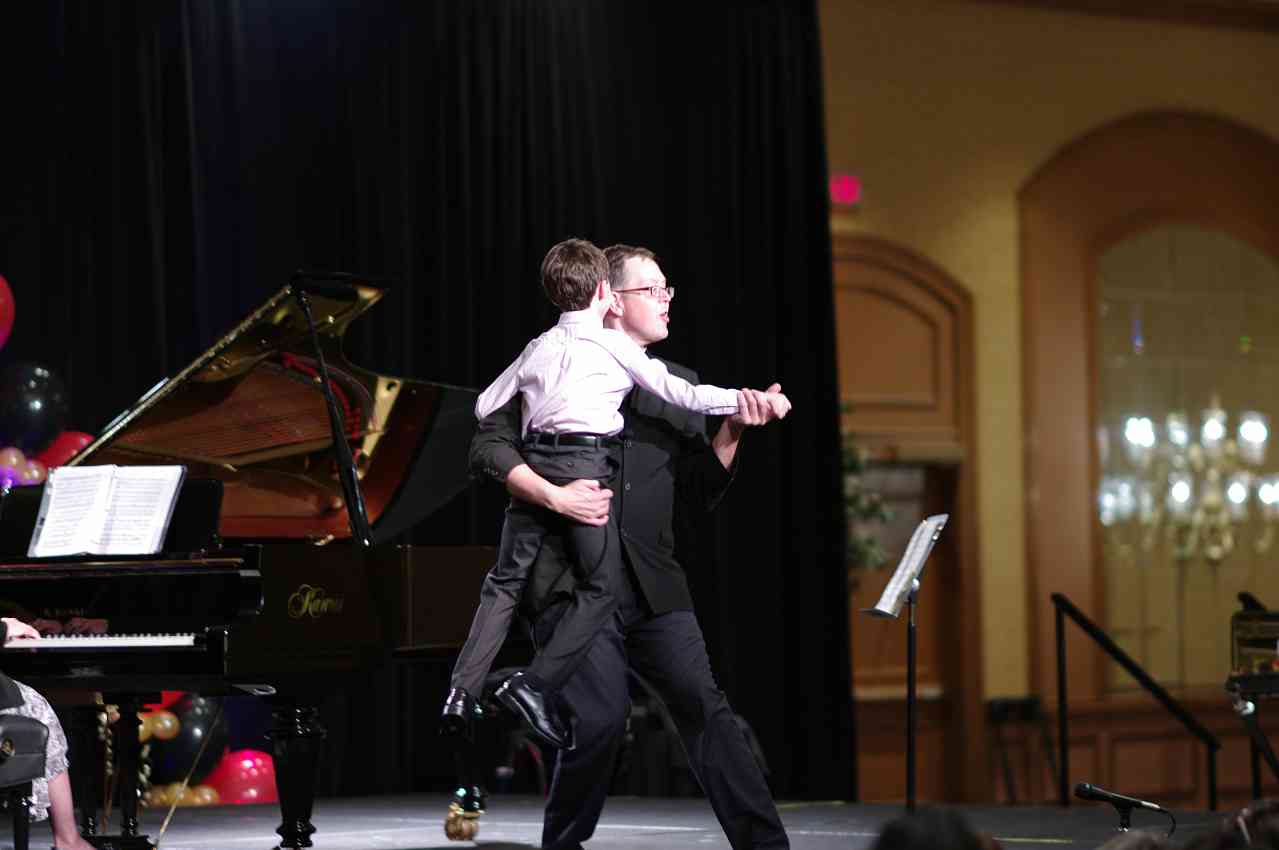
Violin master class with Brian Lewis
Guest artist Brian Lewis conducted violin master classes with students Benjamin Brashear (Wieniawski Concerto No. 2 in d minor, 3rd mvt.), Maya Anjali Buchanan (Paganini Caprice No. 20), Finian Burns (de Beriot Scene de Ballet), Serena Harnack (Wieniawski Concerto No. 2 in d minor, 1st mvt.) and Sam Lord (Lalo Symphonie Espagnole, 1st mvt.). Mr. Lewis helped each student find an important “nugget” and proceeded to work on it with humor, imagery, metaphors, and movement. Here are some of the delightful gems captured during this master class:
- Virtuosity is not about speed; virtuosity is about control.
- Spiccato is legato that is off the string.
- Every day we practice those things that are good for us.
- Practice at the part of the bow where you want to perform.
- The faster we go, the smaller the bow.
- Our main goal is to be heard!
Mr. Lewis also identified what he called the five building block concertos: Bruch Concerto in g minor, Mendelssohn Concerto in e minor, Wieniawski Concerto No. 2 in d minor, Lalo Symphonie Espagnole, and Saint Saens Concerto No. 3 in b minor.
A panel of presenters comprised of Christie Felsing, Susan Kempter, Allen Lieb, Vera McCoy-Sulentic, Kimberly Meier-Sims, Margaret Shimizu, and Carol Smith shared memories and some legendary teaching points of a beloved Suzuki pioneer in “A Few Ideas from John Kendall’s Teaching Legacy.” We were reminded of some of Kendall’s favorite mottos, such as use the pieces to build your technique; be your own Sevcik; finger, bow, go; Witches’ Dance upbeat; principles, not rules; stop–think–play; trill with your bow; keep the elbows moving; teach the big muscles first; and reduce it to open strings. And who among us hasn’t been influenced by his ideas on unit practicing? This was a true celebration of John Kendall’s life and all of the pedagogical gems that he shared with the Suzuki community.
Perennial favorite Bill Starr presented a witty and humorous session titled “Past Ideas Revisited, New Ideas Presented.” He encouraged us to think creatively about finding a meaningful approach for each child, stressing that the most important factor in a child’s ability to learn is the child’s own self image. Mr. Starr also pointed out commonalities between the teaching of Leopold Auer and Dr. Suzuki, especially the idea of deriving technical exercises from the violin repertoire rather than using technique books such as Sevcik. Mr. Starr proposed four goals of practice:
- Be able to play the piece
- Be able to transfer concepts from one piece to similar pieces
- Become better acquainted with the bow and the violin
- Acquire mental control of physical actions
Another interesting idea is that all pieces should begin up-bow, even if that up-bow is a silent motion to place the bow on the string for the following down-bow. We are grateful to have Dr. Suzuki’s “new ideas” being carried on by Bill Starr at the 2012 Conference!
Many friends and colleagues put their journalistic skills to work by contributing to the violin conference summary. Special thanks to Liz Arbus, Ruth Marie Ballance, Ruth Bergman, Becky Ensworth, Stephanie Ezerman, Colleen Fitzgerald, Julia Hardie, Daphne Hughes, Susan McDonald, Irene Mitchell, Ann Montzka-Smelser, Laurie Niles, Kathleen Spring, and Kathy Wood.
